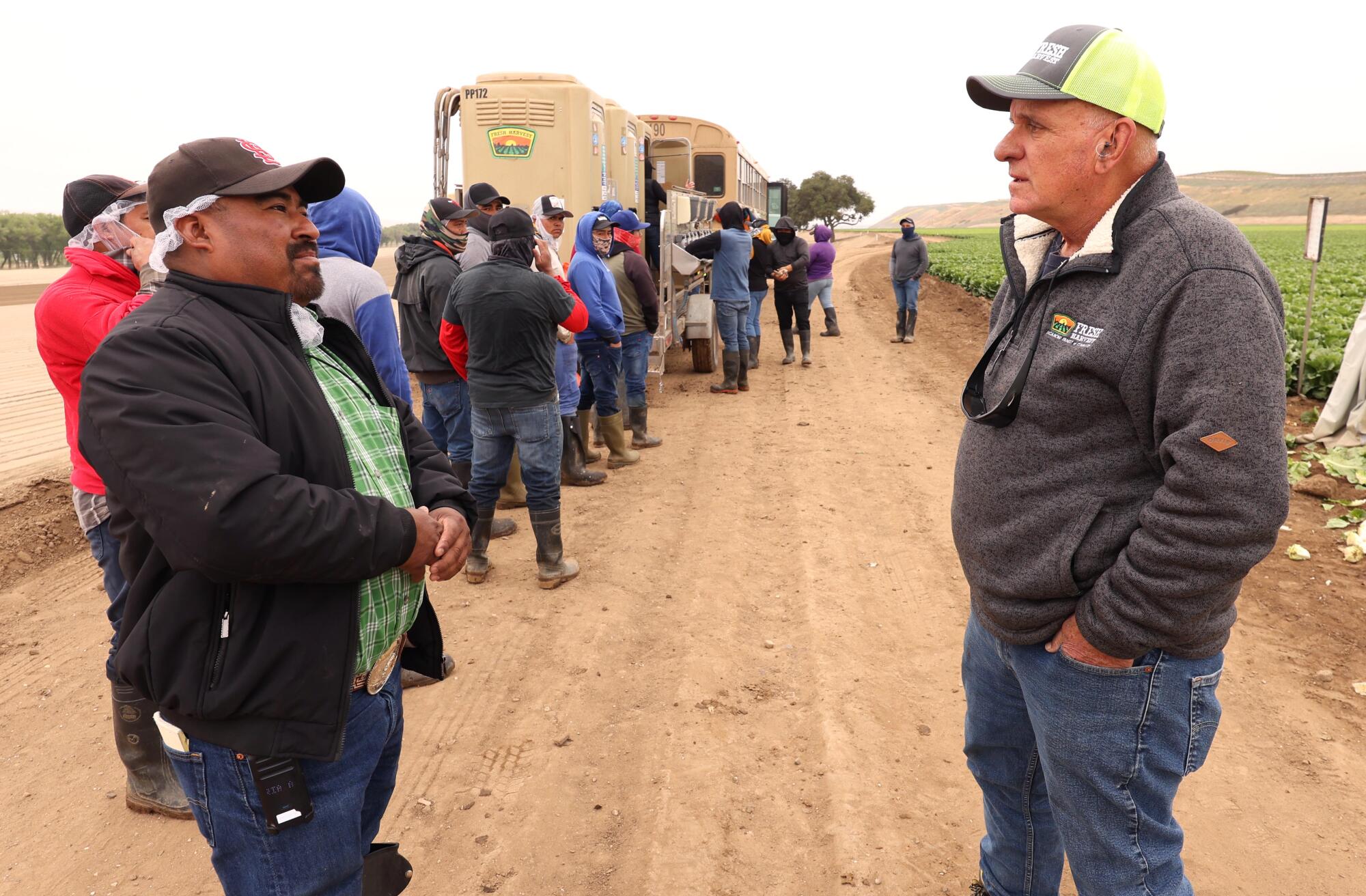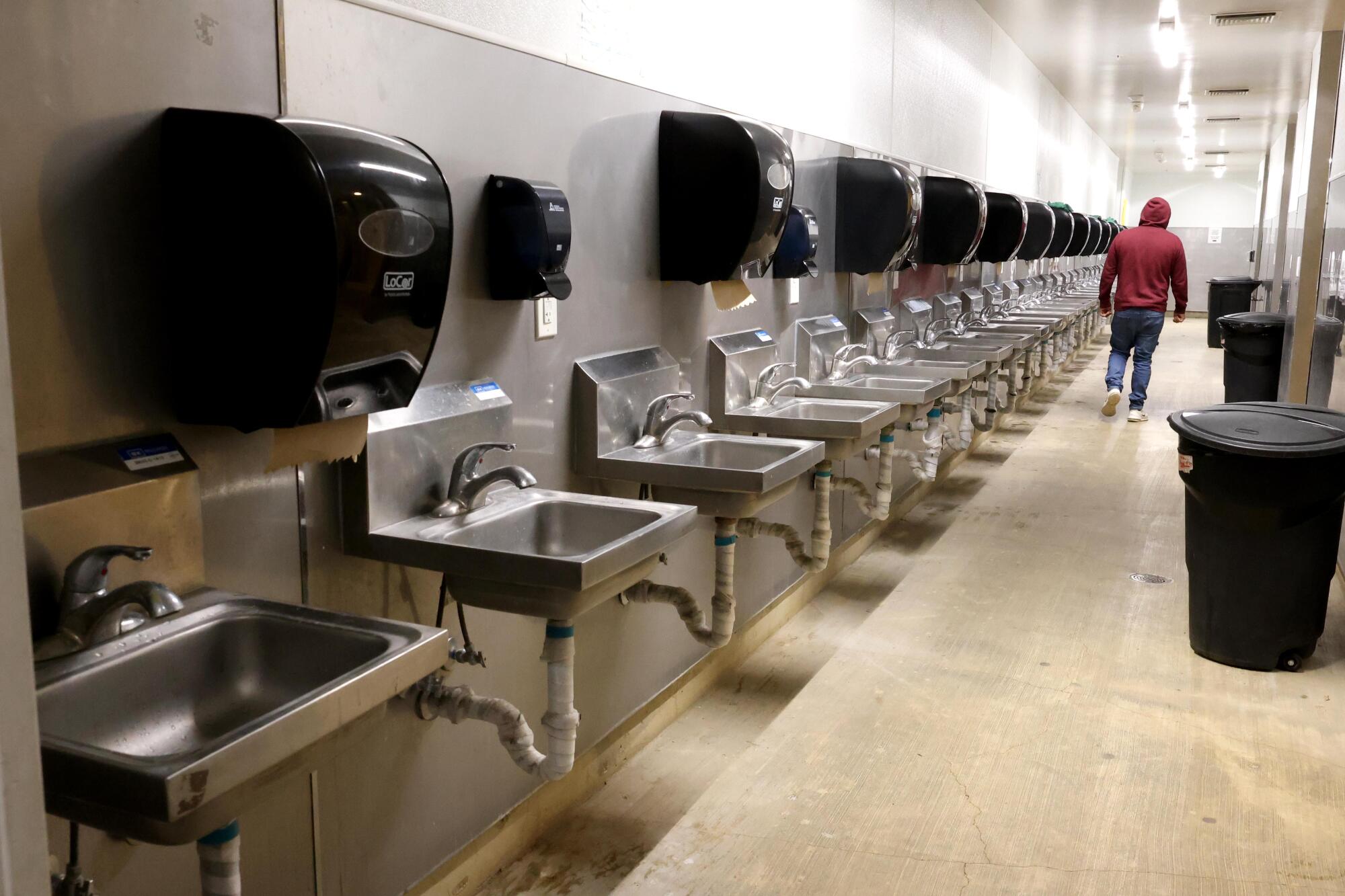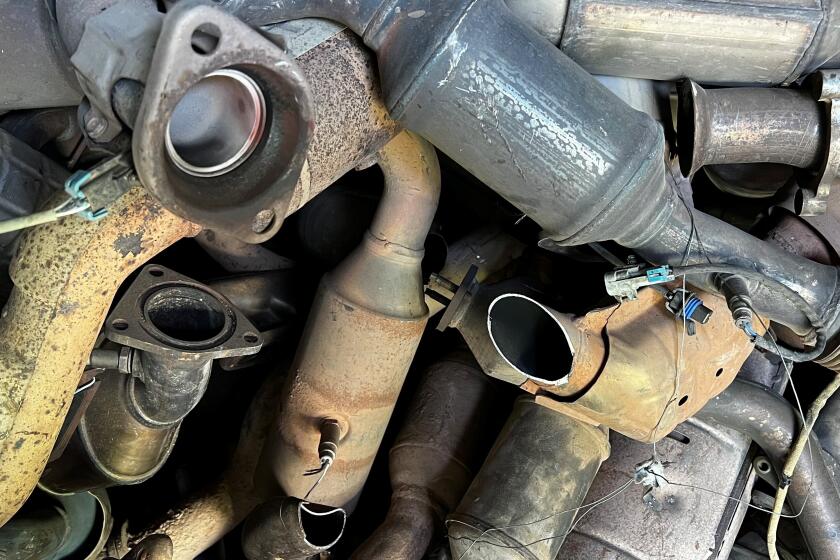
- Share via
SALINAS, Calif. — Every year, farmers in this fertile valley dubbed the “salad bowl of the world” rely on tens of thousands of workers to harvest leafy greens and juicy strawberries. But with local farmworkers aging — and the Trump administration’s determined crackdown on the illegal workers who have long been the backbone of California’s agricultural workforce — more growers have been looking to legal channels to import foreign workers.
Under the federal H-2A visa program, agricultural employers can hire workers from other countries on a temporary basis, so long as they show that they were unable to hire sufficient numbers of domestic workers. Employers are required to provide the guest workers with housing, food and transportation.
But in Monterey County, one of the more expensive regions in the nation, the obligation to provide an exploding number of guest workers with suitable housing was exacerbating a regional affordable housing crisis. Growers and labor contractors were buying up single-family homes and motels — often the residence of last resort for people on the verge of homelessness — making housing even more scarce for low-wage workers living in the region year-round.

For some large farming companies in the county, the solution has been to privately fund the construction of new housing facilities for H-2A workers. Since 2015, local growers have invested their own capital and often their own land to build at least eight housing complexes for thousands of guest workers.
These are not akin to the crude barracks used to house the Mexican guest workers known as braceros decades ago, nor are they the broken-down trailers associated with abuses of the H-2A program. Rather, many of the new housing developments here are built along the lines of modern multi-family townhomes, outfitted with recreational areas and laundry facilities. County leaders, eager to support the agricultural industry and increase the overall housing supply, have thrown their support behind the effort, expediting the permitting processes for such developments.
Some community members are skeptical of this approach. Neighbors have raised concerns about the impacts of building large housing developments primarily for single men. Some advocates say it is a grave injustice that growers are building housing for foreign guest workers, while farmworkers who settled in the region years ago often persist in substandard and overcrowded buildings.

“The growers are building housing for H-2A workers, because they have the power, because they have the land, and because they have the money,” said Nidia Soto, an organizer with Building Healthy Communities Monterey County.
Domestic farmworkers — many of whom emigrated decades ago, started families and put down roots — don’t directly benefit from that development, she said: “Even though they are breaking their backs every day to bring food to the table, they are not worthy of housing.”
County Supervisor Luis Alejo agreed there is a dire need for more affordable housing for local farmworkers, but called the grower-funded H-2A housing developments a “win-win for the community.”
“When we’re providing housing for H-2A workers, it is not exacerbating the housing crisis elsewhere in our community,” he said.
A key issue in the discussion is that many of the longtime farmworkers who live in Monterey County are in the U.S. without authorization, as is true across California. At least half of the estimated 255,700 farmworkers in California are undocumented, according to UC Merced research.
Even in liberal-leaning California, undocumented immigrants who have worked here for decades are making plans to leave, choosing to depart on their own terms rather than risk being forced out with nothing.
With the Trump administration’s focus on upending America’s immigration system and deporting undocumented immigrants, California growers are scrambling to stabilize their labor supply through legal avenues such as the H-2A visa program.
For years, farmworker advocates have voiced concerns about the H-2A program, saying it is ripe for exploitation because a worker’s permission to be in the country is tied to the employer. And, as long as their labor supply was sufficient, many growers were reluctant to scale up the program, because it requires them to invest in federally compliant housing and, in many cases, to pay higher wages to meet a federal requirement of nearly $20 an hour.
But with the Trump administration vowing mass deportations — and a growing number of undocumented immigrants considering “self-deportation” — the sufficiency of the workforce is suddenly in question.

“If we get immigration enforcement, there’s going to be crops rotting in the field,” said Steve Scaroni, founder of Imperial County-based Fresh Harvest, one of the largest enterprises in the country for importing guest workers.
Could Monterey County offer a solution for the rest of the state?
In 2015, Tanimura & Antle, one of the region’s largest agricultural companies, recruited Avila Construction Co. to build housing for 800 H-2A workers in the community of Spreckels outside Salinas.
The grower wanted the project built within one year, which was “kind of unheard of,” because getting housing approved that quickly was nearly impossible, according to Mike Avila, the construction company owner. But Tanimura & Antle faced a dire situation: They couldn’t hire a stable domestic workforce, and risked having crops go unharvested if they didn’t invest in a plan to hire guest workers.
Some local residents opposed the proposed development, citing the dangers of having hundreds more men living in the area and raising concerns about road congestion. But the Board of Supervisors ultimately pushed the project forward.
“We’ve been very, very fortunate that these projects have been built and those fears don’t end up coming to fruition,” Avila said. He noted that employers are required to provide H-2A workers with transportation by bus or van, reducing the number of cars on the road.

Tanimura & Antle’s complex pioneered a new model of guest worker housing in the region, and also gave the company an edge. Once Tanimura & Antle built the complex, it was able to recruit migrant farmworkers from other states, Avila said. It wasn’t until recently that the company began housing H-2A workers in the facility.
Avila, meanwhile, has become the go-to construction company for grower-funded employee housing. The company typically builds dormitory-style townhomes on land owned by growers. Today, the company averages a project a year.


The number of H-2A visas certified for Monterey County has ballooned since that first grower-funded housing development went up.
The federal Labor Department certified more than 8,100 H-2A visas for the county in 2023, a nearly 60% increase from 2018, according to a report from the UC Davis Labor and Community Center of the Greater Capital Region. Compared with other California counties, Monterey had the highest number of visa certifications by several thousand.

Some agricultural employers have had to get creative to meet the housing requirements.
Fresh Harvest houses anywhere between 5,000 and 6,000 guest workers across the U.S. But one of Scaroni’s favorite projects is in King City in a shuttered tomato packaging plant that sat empty until he asked officials about converting it into farmworker housing in 2016.
“The city thought we were crazy,” he recalled. “But there was something in me that said, ‘I think we can make it work.’”
Today, Fresh Harvest’s Meyer Farmworker Housing has space for about 360 workers. The company turned the so-called ripening rooms, where tomatoes once were stored, into dorm rooms that hold 14 workers each.
The dorm rooms are lined with lockers and bunk beds, which workers decorate with colorful blankets. The shared bathroom features a long row of stainless steel sinks and showers, and workers can relax in a community room lined with couches, laundry machines and a TV.
Company officials also tout their impact on King City’s downtown. Broadway Street had defunct storefronts when Fresh Harvest began leasing the property. Now, a La Plaza Bakery opens before sunrise and caters to workers headed to the fields, and restaurants line the streets.
Cristina Cruz Mendoza recently relocated her store, Cristina’s Clothing and More, to Broadway. She sells an array of clothing and gear worn by farmworkers, and says the workers who live nearby have made a big difference to her sales.

Julio Cesar, who has worked with Fresh Harvest for six seasons, said he likes the Meyer facility because of its cleanliness and how cool it stays. He and the other workers who live there often head downtown after working in the broccoli fields.
“We’re all co-workers, and we all respect each other,” he said. “We sometimes go to the stores, do some shopping. Sometimes we go for a walk to relax.”
Even as Monterey County celebrates its successes in building model housing for H-2A guest workers, housing for the thousands of longtime farm laborers who are not part of the visa program continues to stagnate.
A 2018 report from the California Institute for Rural Studies found communities across the Salinas Valley in Monterey County and Pajaro Valley in neighboring Santa Cruz County needed more than 45,000 new units of housing to alleviate critical overcrowding in farmworker households. But building such developments without grower investment requires local governments to cobble together financing, which can be difficult for rural communities.
That’s left many farmworker families struggling to afford rent while earning minimum wage, $16.50 an hour. The situation is especially acute in Salinas, where the City Council recently voted to repeal a short-lived ordinance that capped annual rent increases on multi-family residences built before February 1995.
Amalia Francisco, a 32-year-old immigrant from southern Mexico, shares a three-bedroom house in Salinas with her three brothers and other roommates. It often takes at least three or four families to cover the monthly rent of $5,000, she said.
Francisco makes about $800 a week picking strawberries — that is, if she’s lucky to get a full 40 hours. Her last paycheck was just $200, she said. She feels like she never has enough money to cover her portion of the rent, along with food and other expenses.

Farmworker Aquilino Vasquez pays $2,400 a month to live in a two-bedroom apartment with his wife, three daughters and father-in-law. They have lived there for a decade, but over the past two years Vasquez said he has grown frustrated with the way the property is managed.
When black mold appeared on the ceiling, he said, he was told he was responsible for cleaning it. He said he had to complain to the city to get smoke detectors installed, and that rats have chewed through walls in the bathroom and kitchen.
Vasquez, an immigrant from Oaxaca, said it is unjust that his family’s well-being is at risk, while guest workers are being provided with quality housing.
“They’re building, they’re always building, but for the contract workers,” he said.
This article is part of The Times’ equity reporting initiative, funded by the James Irvine Foundation, exploring the challenges facing low-income workers and the efforts being made to address California’s economic divide.
More to Read
Sign up for Essential California
The most important California stories and recommendations in your inbox every morning.
You may occasionally receive promotional content from the Los Angeles Times.














